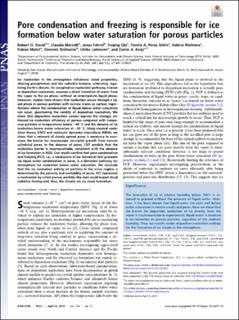Please use this identifier to cite or link to this item:
https://doi.org/10.21256/zhaw-3312| Publication type: | Article in scientific journal |
| Type of review: | Peer review (publication) |
| Title: | Pore condensation and freezing is responsible for ice formation below water saturation for porous particles |
| Authors: | David, Robert O. Marcolli, Claudia Fahrni, Jonas Qiu, Yuqing Perez Sirkin, Yamila A. Molinero, Valeria Mahrt, Fabian Brühwiler, Dominik Lohmann, Ulrike Kanji, Zamin A. |
| DOI: | 10.21256/zhaw-3312 10.1073/pnas.1813647116 |
| Published in: | Proceedings of the National Academy of Sciences of the United States of America |
| Volume(Issue): | 116 |
| Issue: | 17 |
| Page(s): | 8184 |
| Pages to: | 8189 |
| Issue Date: | 2019 |
| Publisher / Ed. Institution: | National Academy of Sciences |
| ISSN: | 0027-8424 1091-6490 |
| Language: | English |
| Subjects: | Cirrus; Cloud; Deposition nucleation; Ice nucleation; Pore condensation and freezing |
| Subject (DDC): | 551: Geology and hydrology |
| Abstract: | Ice nucleation in the atmosphere influences cloud properties, altering precipitation and the radiative balance, ultimately regulating Earth's climate. An accepted ice nucleation pathway, known as deposition nucleation, assumes a direct transition of water from the vapor to the ice phase, without an intermediate liquid phase. However, studies have shown that nucleation occurs through a liquid phase in porous particles with narrow cracks or surface imperfections where the condensation of liquid below water saturation can occur, questioning the validity of deposition nucleation. We show that deposition nucleation cannot explain the strongly enhanced ice nucleation efficiency of porous compared with nonporous particles at temperatures below -40 °C and the absence of ice nucleation below water saturation at -35 °C. Using classical nucleation theory (CNT) and molecular dynamics simulations (MDS), we show that a network of closely spaced pores is necessary to overcome the barrier for macroscopic ice-crystal growth from narrow cylindrical pores. In the absence of pores, CNT predicts that the nucleation barrier is insurmountable, consistent with the absence of ice formation in MDS. Our results confirm that pore condensation and freezing (PCF), i.e., a mechanism of ice formation that proceeds via liquid water condensation in pores, is a dominant pathway for atmospheric ice nucleation below water saturation. We conclude that the ice nucleation activity of particles in the cirrus regime is determined by the porosity and wettability of pores. PCF represents a mechanism by which porous particles like dust could impact cloud radiative forcing and, thus, the climate via ice cloud formation. |
| URI: | https://digitalcollection.zhaw.ch/handle/11475/16910 |
| Fulltext version: | Published version |
| License (according to publishing contract): | CC BY-NC-ND 4.0: Attribution - Non commercial - No derivatives 4.0 International |
| Departement: | Life Sciences and Facility Management |
| Organisational Unit: | Institute of Chemistry and Biotechnology (ICBT) |
| Published as part of the ZHAW project: | Untersuchung der Eisbildungsmechanismen in der Atmosphäre |
| Appears in collections: | Publikationen Life Sciences und Facility Management |
Files in This Item:
| File | Description | Size | Format | |
|---|---|---|---|---|
| 8184.full.pdf | 1.47 MB | Adobe PDF |  View/Open |
Show full item record
David, R. O., Marcolli, C., Fahrni, J., Qiu, Y., Perez Sirkin, Y. A., Molinero, V., Mahrt, F., Brühwiler, D., Lohmann, U., & Kanji, Z. A. (2019). Pore condensation and freezing is responsible for ice formation below water saturation for porous particles. Proceedings of the National Academy of Sciences of the United States of America, 116(17), 8184–8189. https://doi.org/10.21256/zhaw-3312
David, R.O. et al. (2019) ‘Pore condensation and freezing is responsible for ice formation below water saturation for porous particles’, Proceedings of the National Academy of Sciences of the United States of America, 116(17), pp. 8184–8189. Available at: https://doi.org/10.21256/zhaw-3312.
R. O. David et al., “Pore condensation and freezing is responsible for ice formation below water saturation for porous particles,” Proceedings of the National Academy of Sciences of the United States of America, vol. 116, no. 17, pp. 8184–8189, 2019, doi: 10.21256/zhaw-3312.
DAVID, Robert O., Claudia MARCOLLI, Jonas FAHRNI, Yuqing QIU, Yamila A. PEREZ SIRKIN, Valeria MOLINERO, Fabian MAHRT, Dominik BRÜHWILER, Ulrike LOHMANN und Zamin A. KANJI, 2019. Pore condensation and freezing is responsible for ice formation below water saturation for porous particles. Proceedings of the National Academy of Sciences of the United States of America. 2019. Bd. 116, Nr. 17, S. 8184–8189. DOI 10.21256/zhaw-3312
David, Robert O., Claudia Marcolli, Jonas Fahrni, Yuqing Qiu, Yamila A. Perez Sirkin, Valeria Molinero, Fabian Mahrt, Dominik Brühwiler, Ulrike Lohmann, and Zamin A. Kanji. 2019. “Pore Condensation and Freezing Is Responsible for Ice Formation below Water Saturation for Porous Particles.” Proceedings of the National Academy of Sciences of the United States of America 116 (17): 8184–89. https://doi.org/10.21256/zhaw-3312.
David, Robert O., et al. “Pore Condensation and Freezing Is Responsible for Ice Formation below Water Saturation for Porous Particles.” Proceedings of the National Academy of Sciences of the United States of America, vol. 116, no. 17, 2019, pp. 8184–89, https://doi.org/10.21256/zhaw-3312.
Items in DSpace are protected by copyright, with all rights reserved, unless otherwise indicated.